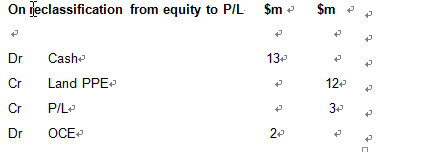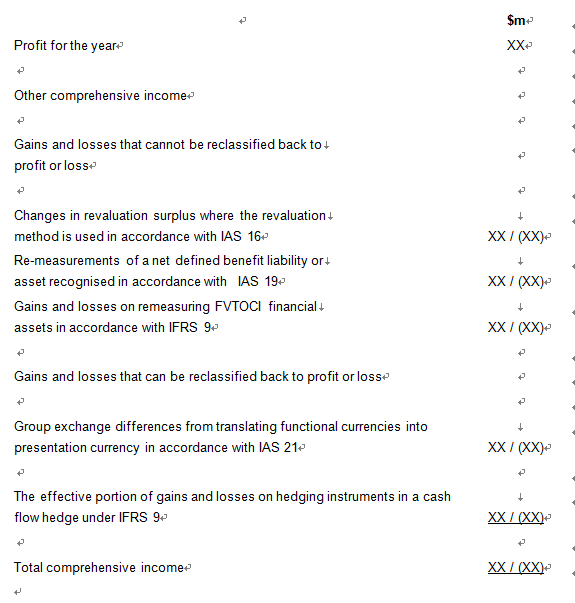掃碼下載APP
及時(shí)接收考試資訊及
備考信息

 新用戶掃碼下載
新用戶掃碼下載安卓版本:8.7.95 蘋果版本:8.7.95
開(kāi)發(fā)者:北京正保會(huì)計(jì)科技有限公司
應(yīng)用涉及權(quán)限:查看權(quán)限>
APP隱私政策:查看政策>
HD版本上線:點(diǎn)擊下載>
If IAS 16 PPE allowed the reclassification from equity to P&L as a reclassification adjustment, the profit on disposal recognised in P&L would be $3m including the $2m reclassified from equity to P&L and the last two double entries above replaced with the following.

IFRS 9 also prohibits the recycling of the gains and losse on FVTOCI investments to P/L on disposal. The no reclassification rule in both IAS 16 PPE and IFRS 9 means that such gains on those assets are only ever reported once in the statement of profit or loss and other comprehensive income – ie are only included once in total comprehensive income. However many users, it appears, rather ignore the total comprehensive income and the OCI and just base their evaluation of a company’s performance on the P/L. These users then find it strange that gains that have become realised from transactions in the accounting period are not fully reported in the P/L of the accounting period. As such we can see the argument in favour of reclassification. With no reclassification the earnings per share will never fully include the gains on the sale of PPE and FVTOCI investments.
The following extract from the statement of comprehensive income summarises the current accounting treatment for which gains and losses are required to be included in OCI and, as required, discloses which gains and losses can and cannot be reclassified back to profit and loss.
Extract from the statement of profit or loss and other comprehensive income

The future of reclassification
In the July 2013 discussion paper on the Conceptual Framework for Financial Reporting the role of the OCI and the reclassification from equity to P/L is debated.
No OCI and no reclassification
It can be argued that reclassification should simply be prohibited. This would free the statement of profit or loss and other comprehensive income from the need to formally to classify gains and losses between P/L and OCI. This would reduce complexity and gains and losses could only ever be recognised once. There would still remain the issue of how to define the earnings in earnings per share, a ratio loved by investors, as clearly total comprehensive income would contain too many gains and losses that were non-operational, unrealised, outside the control of management and not relating to the accounting period.
Narrow approach to the OCI
Another suggestion is that the OCI should be restricted, should adopt a narrow approach. On this basis only bridging and mismatch gains and losses should be included in OCI and be reclassified from equity to P/L.
A revaluation surplus on a financial asset classified as FVTOCI is a good example of a bridging gain. The asset is accounted for at fair value on the statement of financial position but effectively at cost in P/L. As such, by recognising the revaluation surplus in OCI, the OCI is acting as a bridge between the statement of financial position and the P/L. On disposal reclassification ensures that the amount recognised in P/L will be consistent with the amounts that would be recognised in P/L if the financial asset had been measured at amortised cost.
The effective gain or loss on a cash flow hedge of a future transaction is an example of a mismatch gain or loss as it relates to a transaction in a future accounting period so needs to be carried forward so that it can be matched in the P/L of a future accounting period. Only by recognising the effective gain or loss in OCI and allowing it to be reclassified from equity to P/L can users to see the results of the hedging relationship.
Broad approach to the OCI
A third proposition is for the OCI to adopt a broad approach, by also including transitory gains and losses. The IASB would decide in each IFRS whether a transitory remeasurement should be subsequently recycled.
Examples of transitory gains and losses are those that arise on the remeasurement of defined benefit pension funds and revaluation surpluses on PPE.
Conclusion
Whilst the IASB has not yet determined which approach will be adopted, its chairman Hans Hoogervorst has gone on the record as saying ‘It is absolutely vital that the P/L contains all information that can be relevant to investors and that nothing of importance gets left out… and… the IASB should be very disciplined in its use of OCI as resorting to OCI too easily would undermine the credibility of net income so the OCI should only be used as an instrument of last resort’. Now that sounds like a personal endorsement of the narrow approach to me!
Tom Clendon is a lecturer at FTMS based in Singapore and is the author of the second edition of A Student's Guide to Group Accounts (published by Kaplan Publishing)

Jessie主講:《FR 財(cái)務(wù)報(bào)告》免費(fèi)聽(tīng)

張宏遠(yuǎn)主講:《MA 管理會(huì)計(jì)》免費(fèi)聽(tīng)

何 文主講:《SBL 戰(zhàn)略商業(yè)領(lǐng)袖》免費(fèi)聽(tīng)

歷年樣卷

考試大綱

詞匯表

報(bào)考指南

考官文章

思維導(dǎo)圖
 新用戶掃碼下載
新用戶掃碼下載安卓版本:8.7.95 蘋果版本:8.7.95
開(kāi)發(fā)者:北京正保會(huì)計(jì)科技有限公司
應(yīng)用涉及權(quán)限:查看權(quán)限>
APP隱私政策:查看政策>
HD版本上線:點(diǎn)擊下載>

官方公眾號(hào)
微信掃一掃

官方視頻號(hào)
微信掃一掃

官方抖音號(hào)
抖音掃一掃
Copyright © 2000 - www.electedteal.com All Rights Reserved. 北京正保會(huì)計(jì)科技有限公司 版權(quán)所有
京B2-20200959 京ICP備20012371號(hào)-7 出版物經(jīng)營(yíng)許可證 ![]() 京公網(wǎng)安備 11010802044457號(hào)
京公網(wǎng)安備 11010802044457號(hào)
套餐D大額券
¥
去使用 主站蜘蛛池模板: 国产欧美精品区一区二区三区 | 国产精品一区二区不卡 | 日韩美女视频 | 国产成人精品久久久 | 精品在线免费观看 | 天天操 夜夜操 | 欧美久久成人 | 日韩在线不卡视频 | 成人免费视频网站在线看 | 在线国产一区二区 | 日韩精品国产精品 | 国产成人精品一区二区三区网站观看 | 亚洲国产精品99久久久久久久久 | 水蜜桃一区 | 51精产品一区一区三区 | 成人在线播放网站 | 一区二区国产精品视频 | 久久久国产精品一区二区三区 | 亚洲最大福利网站 | 色片免费 | 欧美婷婷| 久久av红桃一区二区小说 | 日韩欧美不卡视频 | 色免费在线| 成人在线观看视频网站 | 国产精品美女久久 | 丁香六月激情 | 精品久久久免费 | 91精品国产综合久久久久久丝袜 | 中文字幕精品一区久久久久 | 一区免费观看 | 青青青国产在线 | 久久观看 | 久久国产精品免费 | 日韩欧美精品在线 | 日韩av在线网 | 在线免费国产 | 国产精品伦一区二区三级视频 | 国产精品成人一区二区三区夜夜夜 | av久久久| 国产一区二区在线免费观看 |